How to Make Traditional British Pancakes
A simple method for making traditional British pancakes – perfect every time! Plus, plenty of ideas for sweet and savoury pancake toppings.

Happy Pancake Day! I make these traditional British pancakes on Pancake Day every year, and every single time, I remember how incredible they are, and vow to make them more often… and then, obviously, I never do. So if you’re reading this any time after March, please do give me a poke and remind me to make them again!
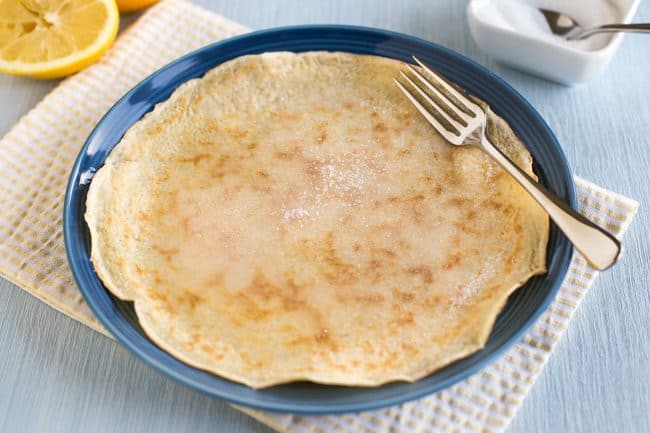
What is Pancake Day?
Just in case you have no clue what I’m talking about, Pancake Day is what we Brits like to call Shrove Tuesday / Mardi Gras / the day before the beginning of Lent.
It seems to be called something different in just about every country, and is celebrated in different ways – in New Orleans in 2016, we celebrated Mardi Gras by drinking beer in the street in the middle of the afternoon, with heaps of plastic beads around our necks. This year, in Hertfordshire (definitely a less exciting location), we will be making pancakes with our toddler and eating about seventeen pancakes each, topped with a squeeze of lemon and sprinkled with an obscene amount of sugar. Both fun, but in very different ways.
Pancake Day is always a Tuesday, but it falls on a different day each year – it depends on the date of Easter, which changes based on the cycles of the moon. In 2020, Pancake Day is today – Tuesday 25th February. Next year, Pancake Day will be on Tuesday 16th February 2021.
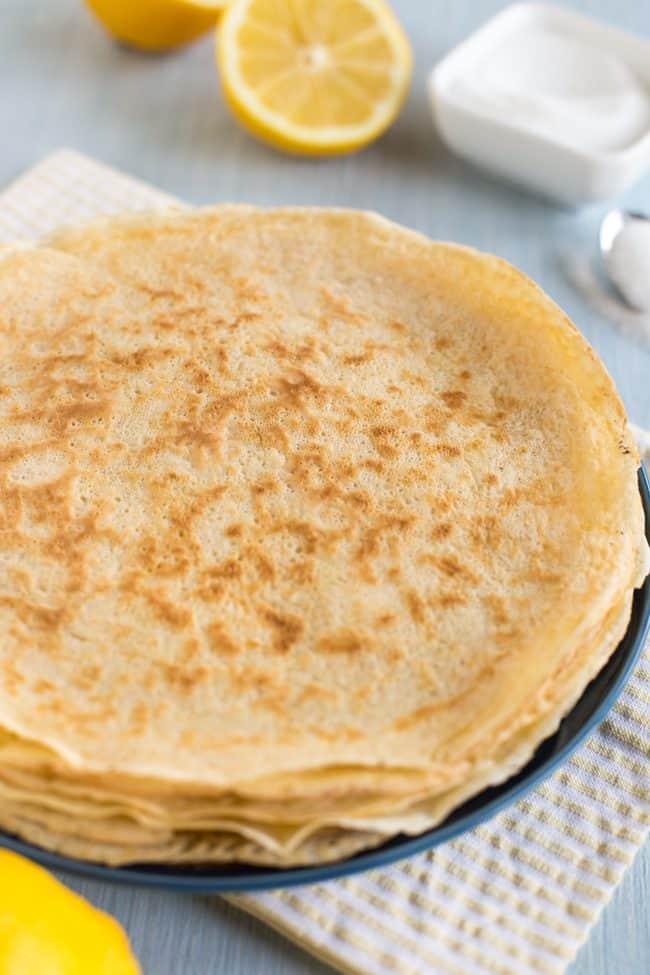
Why do Brits eat pancakes on Shrove Tuesday?
For the majority of Brits, Shrove Tuesday is synonymous with pancakes. It’s one of the few days of the year when pretty much everyone in the UK eats the same meal for dinner (or just for dessert, after a perfectly balanced dinner, if you’re a bit more respectable).
The main reason pancakes started being consumed on Shrove Tuesday was because they were a good way to use up the butter and eggs that would be given up for Lent the next day. These days, of course, not everyone gives these things up for Lent (I’m considering giving up chocolate as a personal challenge, but I’m not sure if that’s one step too far), but we still grab onto any excuse to make pancakes for dinner.
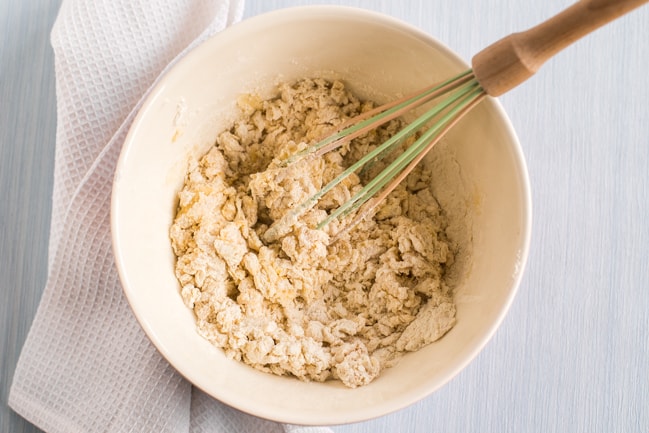
Traditional British pancakes
Traditional British pancakes are nothing like the thick, fluffy pancakes that a lot of you will be familiar with (which are more like what we call Scotch pancakes). They’re a lot more similar to a French crêpe – they’re large and thin, and typically served rolled or folded around some kind of filling.
We don’t generally eat them for breakfast – more for dessert or dinner.
What are the ingredients in British pancakes?
The batter is really easy to make, with just three main ingredients:
- eggs
- flour
- milk
I don’t usually add sugar to my pancake batter – not only does this mean that you can serve them with sweet or savoury toppings depending on your mood, it also means that you can justify sprinkling a lot more sugar on top (or am I just kidding myself?).
Just whisk together the eggs and flour, then gradually add the milk to make a thin batter.
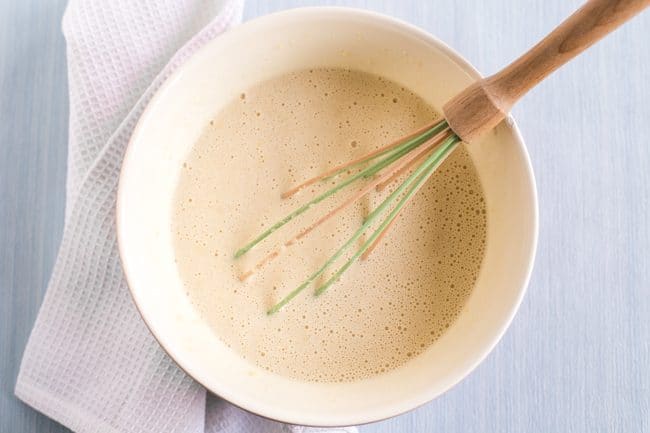
How do you stop pancakes from sticking to the pan?
If you use a good non-stick frying pan, you should be fine – I’ve never had a problem with pancakes sticking to the pan. I have a couple of different Circulon frying pans that I use (Amazon UK* / US*), and I love love love them. They’re really non-stick – you’ve probably seen them cropping up in my blog photos on a regular basis.
But, if you’re concerned, there is an easy way to make your pancake batter non-stick!
You can either add a dash of oil right into the batter, or (much better, in my opinion) some melted butter. Just make sure you whisk the batter as you add the melted butter to prevent lumps forming.
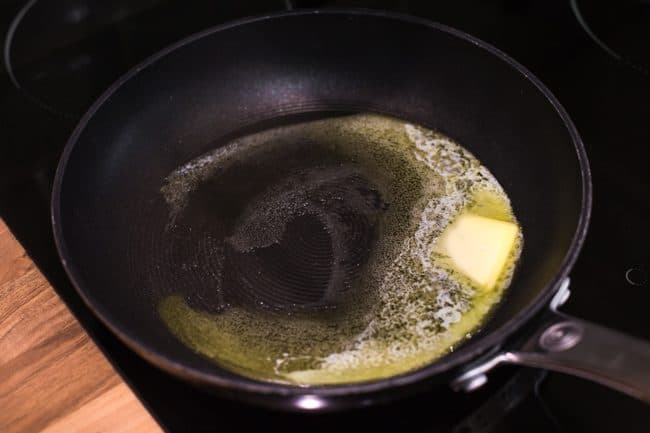
How to cook traditional British pancakes
Then, it’s time to cook! Gently preheat the pan first (you can spray it with a little extra oil if you’re really concerned about sticking – I never find I need to, once I’ve added the butter to the pancake mix), then just ladle in a spoonful of the batter.
There’s a technique that we Brits have perfected over the years, which works perfectly to distribute the batter around the pan – the swirl. Just lift the pan and swirl it around (gently!) in a circular motion until the batter evenly covers the bottom of the pan. Then cook until the bottom of the pancake is golden brown.
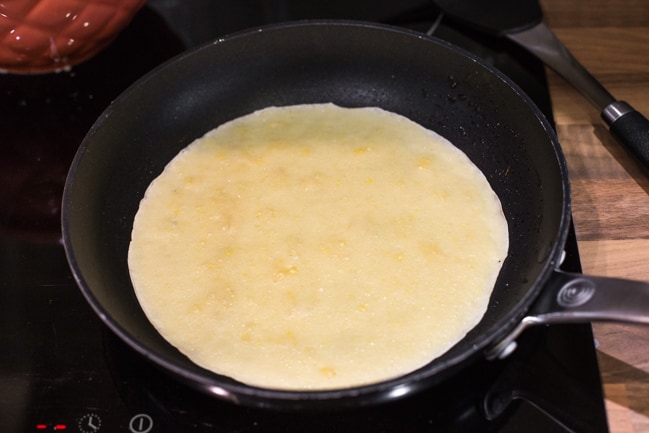
For some reason, the two sides of your pancake will always come out looking totally different. The first side you cook will always end up looking like this:
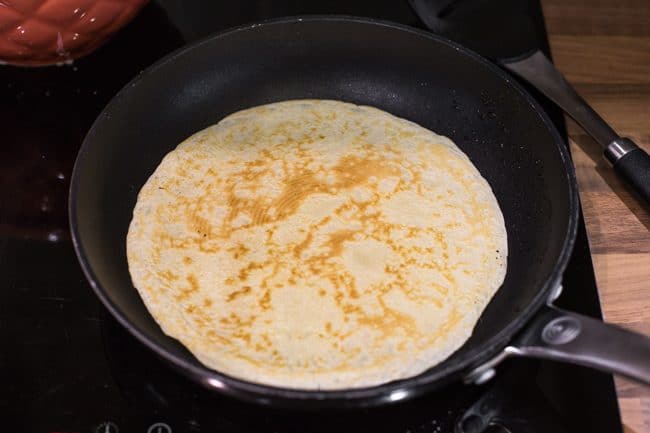
and the second side always looks like this:
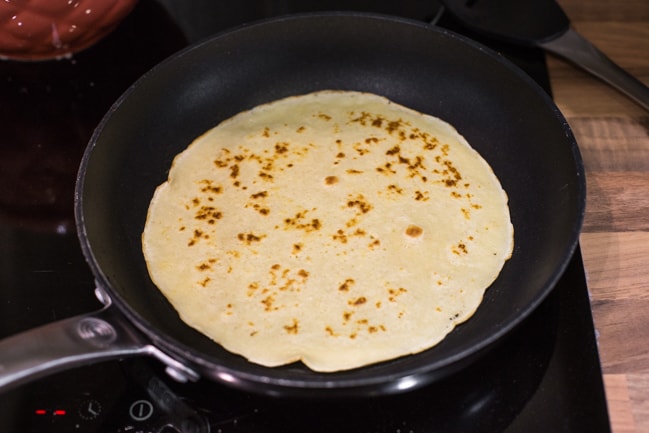
Don’t be alarmed! That’s meant to happen. They end up nice and crispy around the edges, and soft in the middle. Perfect.
Keep going until you’ve cooked the whole batch of batter. Each pancake only takes a couple of minutes to cook each side, but if you’re going to make the full batch of 8-ish pancakes, you can expect to be stood at the hob for a good half hour or so. Luckily, they’re easy to nibble on as you cook – or stack them on a plate in an oven set to the lowest temperature to help keep them warm.
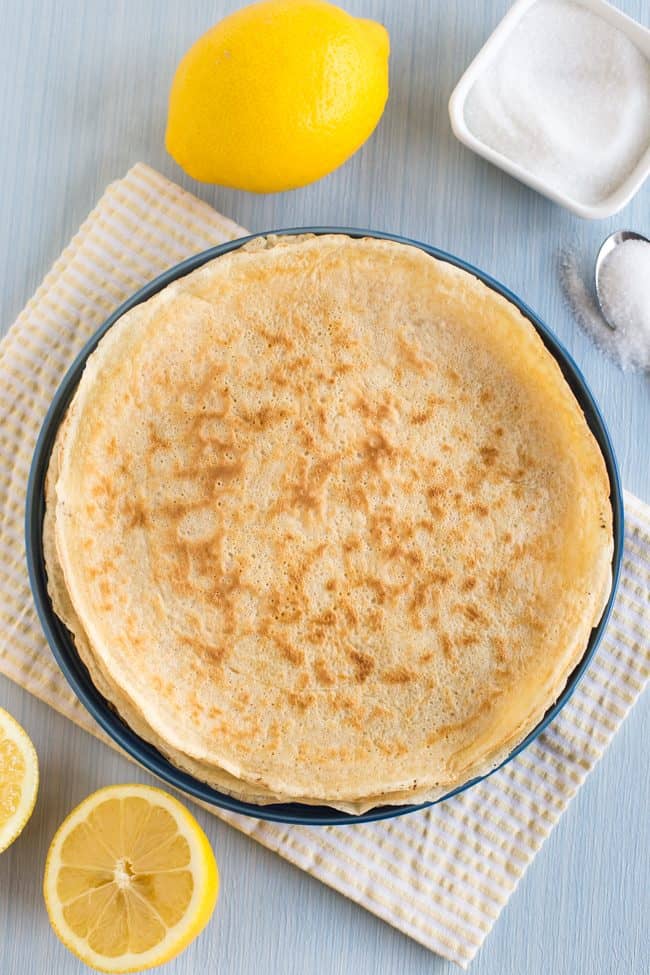
Topping ideas for traditional British pancakes
We Brits don’t discriminate – we love our pancakes with all kinds of toppings.
Our #1 favourite is a generous squeeze of lemon juice (either freshly squeezed or from a bottle), then an obscene amount of sugar to cut through the sharpness. This is how I eat my pancakes 90% of the time.
But there are plenty of other options too!
Sweet pancake topping ideas:
- lemon juice and sugar
- any kind of fruit jam
- chocolate spread
- stewed fruit
- caramel sauce
- honey or maple syrup
- fresh berries
- ice cream
- Greek yogurt
Savoury pancake topping ideas:
- creamy garlic mushrooms
- garlicky spinach and a fried egg
- salsa and guacamole
- cheese and sliced tomatoes
- goat’s cheese and spinach
- spicy beans or chilli
- cream cheese and chilli jam
You can either roll your pancake around your filling like a burrito, fold it into quarters, or just eat it flat like a pizza!
Whichever option you go for, you really can’t go wrong with traditional British pancakes on Pancake Day.
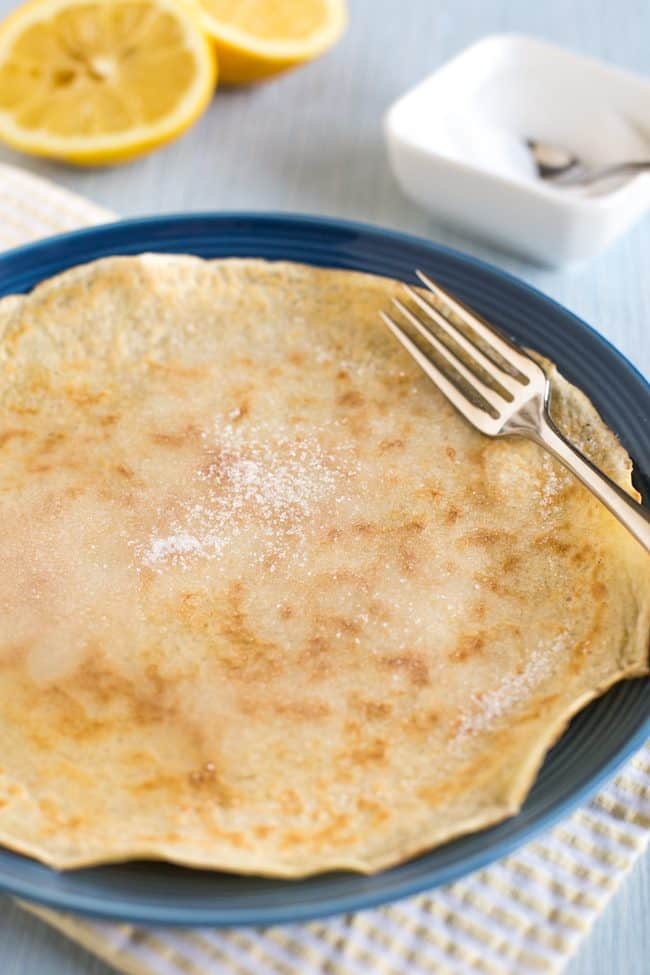
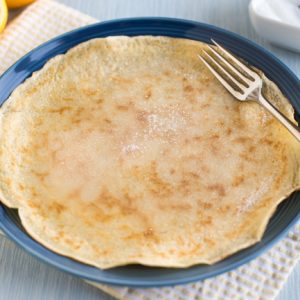
Traditional British pancakes
If you’ve cooked this recipe, don’t forget to leave a star rating!
Print Pin CommentIngredients
- 300 g (~ 2 cups) plain flour
- 3 eggs
- 400 ml (~ 1 2/3 cups) milk
- 1 tbsp butter
- Spray oil, if needed
- To serve: your choice of sweet or savoury toppings (see blog post for ideas!)
Instructions
- Add the flour to a large mixing bowl, and make a well in the centre.
- Combine the eggs and milk in a separate bowl, and briefly whisk together.
- Gradually add the milk mixture to the flour a little at a time, whisking until smooth (don't worry if a few small lumps remain, you won't notice them in the finished pancakes). The batter will be fairly thin.
- Melt the butter in a non-stick frying pan, then pour it back into the pancake batter, whisking to ensure no lumps are formed.
- With the pan over a medium heat (I used setting 5 out of 9), add a ladleful of the pancake batter. Lift the pan, and gently swirl the mixture around the base of the pan until it forms a thin layer all over. Return to the heat, and cook for 2-3 minutes, until the underside of the pancake is lightly golden brown.
- Flip the pancake carefully, and cook the other side for a further 2 minutes. Transfer to a plate while you cook the remaining pancakes. You can spray a little oil into the pan in between pancakes if they’re showing signs of sticking – I didn’t need to.
- When you’ve cooked all fo the batter, serve the pancakes with your choice of sweet or savoury topping.
Nutrition
Nutritional information is approximate, and will depend on your exact ingredients. Please calculate your own nutritional values if you require accuracy for health reasons.
Love my traditional British recipes? Why not have a vegetarian full English breakfast the next morning!
* This post contains affiliate links. As an Amazon Associate, I earn from qualifying purchases.
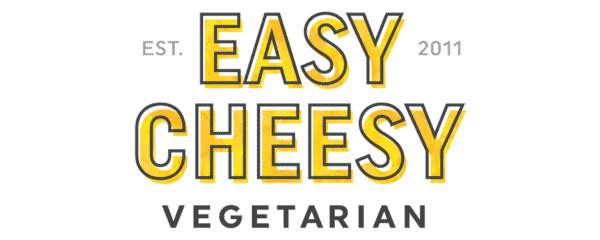
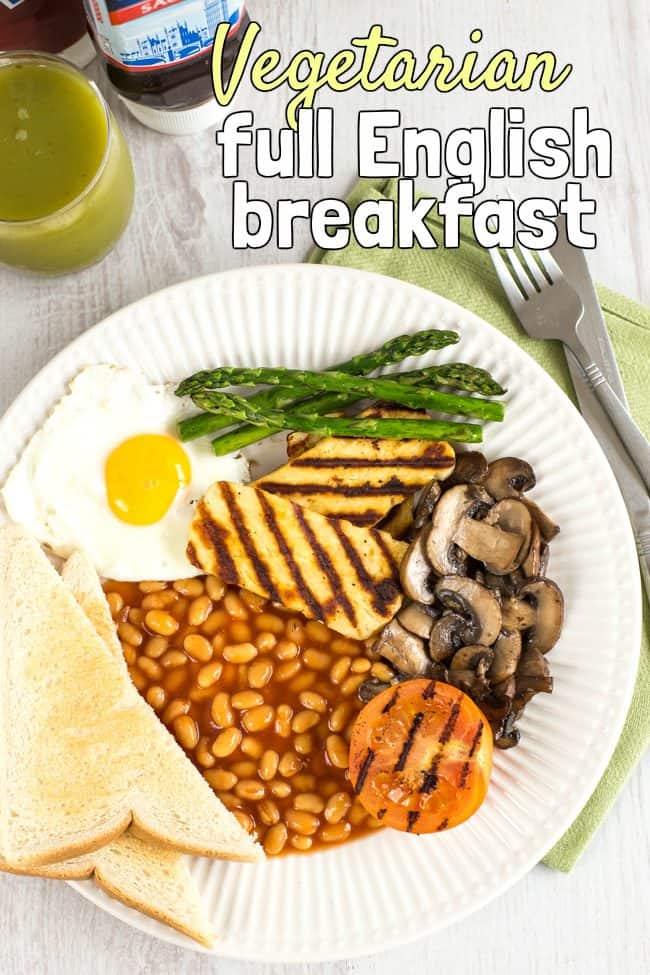
I came from England as a young girl and I remember my mum making these with fresh squeeze oranges instead of lemon. I will have to try lemon instead. On a snowy day here in Colorado, I promised my daughter I’d make both for her this morning. We shall see what her American self likes best. 😊 We shall have to stop at the Stanley to see you. Thanks for the recipe!
Thanks Karen! That’s so interesting, I’ve never heard of anyone here using oranges – lemon and sugar is definitely the traditional way, but oranges sound incredible!
I will be trying these ASAP! My English mother used to make these and I loved them. I have tried ordering crepes from IHOP and they just aren’t the same.
Hope you enjoy them! :)
Feels like a pancake war declaration. No raising agent but called a pancake. In my book, thing should be either an American pancake or a french crepe, all the rest is just made up! 😂
People can add a pinch of salt too, that make the crepe or pancake taste come out more.
You can also opt to get up to half the milk replaced by water for slightly lighter and healthier crepes.
Either an American pancake or a French crepe? What about all the other countries in the world? This is how we make them in England :)
I love pancakes. These are amazing with syrup!
Bought a new teflon pan. Came in the mail yesterday, and my English husband said “lets try english pancakes with lemon and demerara (crunchy) sugar!! ” The pan worked perfect and we were in heaven eating the pancakes with your recipe. I’ll be making them again soon. many thanks.
Thanks so much Hetty, glad you both enjoyed them!